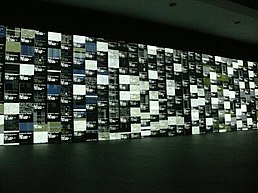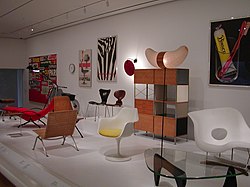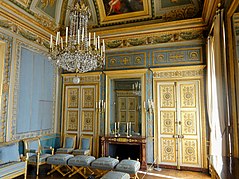Postmodern art
| History of art |
|---|
| Postmodernism |
|---|
| Preceded by Modernism |
| Postmodernity |
| Fields |
|
| Reactions |
| Related |
Postmodern art is a body of art movements that sought to contradict some aspects of modernism or some aspects that emerged or developed in its aftermath. In general, movements such as intermedia, installation art, conceptual art and multimedia, particularly involving video are described as postmodern.
There are several characteristics which lend art to being postmodern; these include
Use of the term
The predominant term for art produced since the 1950s is "contemporary art". Not all art labeled as contemporary art is postmodern, and the broader term encompasses both artists who continue to work in modernist and late modernist traditions, as well as artists who reject postmodernism for other reasons. Arthur Danto argues "contemporary" is the broader term, and postmodern objects represent a "subsector" of the contemporary movement.[3] Some postmodern artists have made more distinctive breaks from the ideas of modern art and there is no consensus as to what is "late-modern" and what is "post-modern." Ideas rejected by the modern aesthetic have been re-established. In painting, postmodernism reintroduced representation.[4] Some critics argue much of the current "postmodern" art, the latest avant-gardism, should still classify as modern art.[5]
As well as describing certain tendencies of contemporary art, postmodern has also been used to denote a phase of modern art. Defenders of modernism, such as Clement Greenberg,[6] as well as radical opponents of modernism, such as Félix Guattari, who calls it modernism's "last gasp,[7]" have adopted this position. The neo-conservative Hilton Kramer describes postmodernism as "a creation of modernism at the end of its tether."[8] Jean-François Lyotard, in Fredric Jameson's analysis, does not hold there is a postmodern stage radically different from the period of high modernism; instead, postmodern discontent with this or that high modernist style is part of the experimentation of high modernism, giving birth to new modernisms.[9] In the context of aesthetics and art, Jean-François Lyotard is a major philosopher of postmodernism.
Many critics hold postmodern art emerges from modern art. Suggested dates for the shift from modern to postmodern include 1914 in Europe,
American Marxist philosopher Fredric Jameson argues the condition of life and production will be reflected in all activity, including the making of art.
As with all uses of the term postmodern, there are critics of its application. Kirk Varnedoe, for instance, stated that there is no such thing as postmodernism, and that the possibilities of modernism have not yet been exhausted.[20] Though the usage of the term as a kind of shorthand to designate the work of certain Post-war "schools" employing relatively specific material and generic techniques has become conventional since the early to mid-1980s, the theoretical underpinnings of Postmodernism as an epochal or epistemic division are still very much in controversy.[21]
Definition
Postmodernism describes movements which both arise from, and react against or reject, trends in
The status of the avant-garde is controversial: many institutions argue being visionary, forward-looking, cutting-edge, and progressive are crucial to the mission of art in the present, and therefore postmodern art contradicts the value of "art of our times". Postmodernism rejects the notion of advancement or progress in art per se, and thus aims to overturn the "myth of the
One characteristic of postmodern art is its conflation of high and low culture through the use of industrial materials and pop culture imagery. The use of low forms of art were a part of modernist experimentation as well, as documented in Kirk Varnedoe and Adam Gopnik's 1990–91 show High and Low: Popular Culture and Modern Art at New York's Museum of Modern Art,[27] an exhibition that was universally panned at the time as the only event that could bring Douglas Crimp and Hilton Kramer together in a chorus of scorn.[28] Postmodern art is noted for the way in which it blurs the distinctions between what is perceived as fine or high art and what is generally seen as low or kitsch art.[29] While this concept of "blurring" or "fusing" high art with low art had been experimented during modernism, it only ever became fully endorsed after the advent of the postmodern era.[29] Postmodernism introduced elements of commercialism, kitsch and a general camp aesthetic within its artistic context; postmodernism takes styles from past periods, such as Gothicism, the Renaissance and the Baroque,[29] and mixes them so as to ignore their original use in their corresponding artistic movement. Such elements are common characteristics of what defines postmodern art.
One compact definition is postmodernism rejects modernism's
Avant-garde precursors
Radical movements and trends regarded as influential and potentially as precursors to postmodernism emerged around World War I and particularly in its aftermath. With the introduction of the use of industrial artifacts in art and techniques such as collage, avant-garde movements such as Cubism, Dada and Surrealism questioned the nature and value of art. New artforms, such as cinema and the rise of reproduction, influenced these movements as a means of creating artworks. The ignition point for the definition of modernism, Clement Greenberg's essay, Avant-Garde and Kitsch, first published in Partisan Review in 1939, defends the avant-garde in the face of popular culture.[32] Later, Peter Bürger would make a distinction between the historical avant-garde and modernism, and critics such as Krauss, Huyssen, and Douglas Crimp, following Bürger, identified the historical avant-garde as a precursor to postmodernism. Krauss, for example, describes Pablo Picasso's use of collage as an avant-garde practice anticipating postmodern art with its emphasis on language at the expense of autobiography.[33] Another point of view is avant-garde and modernist artists used similar strategies and postmodernism repudiates both.[34]
Dada
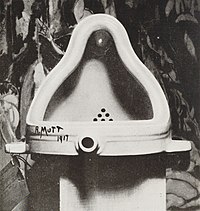
In the early 20th century, Marcel Duchamp exhibited a urinal as a sculpture. His point was to have people look at the urinal as if it were a work of art just because he said it was a work of art.[35][36][37] He referred to his work as "Readymades".[38] The Fountain was a urinal signed with the pseudonym R. Mutt, which shocked the art world in 1917.[39] This and Duchamp's other works are generally labelled as Dada. Duchamp can be seen as a precursor to conceptual art. Some critics question calling Duchamp—whose obsession with paradox is well known—postmodernist on the grounds he eschews any specific medium, since paradox is not medium-specific, although it arose first in Manet's paintings.[40]
Radical movements in modern art
In general,
Jackson Pollock and abstract expressionism
During the late 1940s and early 1950s, Pollock's radical approach to painting revolutionized the potential for all Contemporary art following him. Pollock realized the journey toward making a work of art was as important as the work of art itself. Like Pablo Picasso's innovative reinventions of painting and sculpture near the turn of the century via Cubism and constructed sculpture, Pollock redefined artmaking during the mid-century. Pollock's move from easel painting and conventionality liberated his contemporaneous artists and following artists. They realized Pollock's process — working on the floor, unstretched raw canvas, from all four sides, using artist materials, industrial materials, imagery, non-imagery, throwing linear skeins of paint, dripping, drawing, staining, brushing - blasted artmaking beyond prior boundaries. Abstract expressionism expanded and developed the definitions and possibilities artists had available for the creation of new works of art. In a sense, the innovations of Jackson Pollock, Willem de Kooning, Franz Kline, Mark Rothko, Philip Guston, Hans Hofmann, Clyfford Still, Barnett Newman, Ad Reinhardt and others, opened the floodgates to the diversity and scope of following artworks.[43]
After abstract expressionism
In
By the late 1960s,
Performance art and happenings
During the late 1950s and 1960s, artists with a wide range of interests began pushing the boundaries of
During the same period — the late 1950s through the mid-1960s - various
Assemblage art
Related to
Leo Steinberg uses the term postmodernism in 1969 to describe Rauschenberg's "flatbed" picture plane, containing a range of cultural images and artifacts that had not been compatible with the pictorial field of premodernist and modernist painting.[53] Craig Owens goes further, identifying the significance of Rauschenberg's work not as a representation of, in Steinberg's view, "the shift from nature to culture", but as a demonstration of the impossibility of accepting their opposition.[54]
Steven Best and Douglas Kellner identify Rauschenberg and Jasper Johns as part of the transitional phase, influenced by Marcel Duchamp, between modernism and postmodernism. These artists used images of ordinary objects, or the objects themselves, in their work, while retaining the abstraction and painterly gestures of high modernism.[55]
Anselm Kiefer also uses elements of assemblage in his works, and on one occasion, featured the bow of a fishing boat in a painting.
Pop art
and the others.Thomas McEvilly, agreeing with Dave Hickey, says U.S postmodernism in the visual arts began with the first exhibitions of Pop art in 1962, "though it took about twenty years before postmodernism became a dominant attitude in the visual arts."[11] Fredric Jameson, too, considers pop art to be postmodern.[56]
One way Pop art is postmodern is it breaks down what Andreas Huyssen calls the "Great Divide" between high art and popular culture.[57] Postmodernism emerges from a "generational refusal of the categorical certainties of high modernism."[58]
Fluxus

Fluxus was named and loosely organized in 1962 by
Fluxus encouraged a do it yourself aesthetic, and valued simplicity over complexity. Like Dada before it, Fluxus included a strong current of anti-commercialism and an anti-art sensibility, disparaging the conventional market-driven art world in favor of an artist-centered creative practice. Fluxus artists preferred to work with whatever materials were at hand, and either created their own work or collaborated in the creation process with their colleagues.
Fluxus can be viewed as part of the first phase of postmodernism, along with Rauschenberg, Johns, Warhol and the Situationist International.[59] Andreas Huyssen criticises attempts to claim Fluxus for postmodernism as, "either the master-code of postmodernism or the ultimately unrepresentable art movement – as it were, postmodernism's sublime." Instead he sees Fluxus as a major Neo-Dadaist phenomena within the avant-garde tradition. It did not represent a major advance in the development of artistic strategies, though it did express a rebellion against, "the administered culture of the 1950s, in which a moderate, domesticated modernism served as ideological prop to the Cold War."[60]
Minimalism

By the early 1960s,
Hal Foster, in his essay The Crux of Minimalism, examines the extent to which Donald Judd and Robert Morris both acknowledge and exceed Greenbergian modernism in their published definitions of minimalism.[61] He argues minimalism is not a "dead end" of modernism, but a "paradigm shift toward postmodern practices that continue to be elaborated today."[62]
Postminimalism
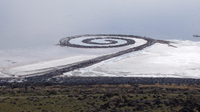
Minimalists like
Movements
Conceptual art
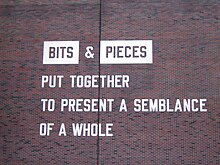
Conceptual art is sometimes labelled as postmodern because it is expressly involved in deconstruction of what makes a work of art, "art". Conceptual art, because it is often designed to confront, offend or attack notions held by many of the people who view it, is regarded with particular controversy.
Precursors to conceptual art include the work of Duchamp,
Figurative painting
Some currents of post-war figurative painting have been analyzed as postmodern. The Italian painter Carlo Maria Mariani was described as a postmodernist by American critics. According to Charles Jencks, Mariani's group portrait The Constellation of Leo (1980–1981), which depicts people from Italy's art world with references to mythology and art history, came to define a trope of postmodern art: "an ironic comment on a comment on a comment which signals the distance; a new myth thrice removed from its originating ritual".[65]
Installation art
An important series of movements in art which have consistently been described as postmodern involved installation art and creation of artifacts that are conceptual in nature. One example being the signs of Jenny Holzer which use the devices of art to convey specific messages, such as "Protect Me From What I Want". Installation Art has been important in determining the spaces selected for museums of contemporary art in order to be able to hold the large works which are composed of vast collages of manufactured and found objects. These installations and collages are often electrified, with moving parts and lights.
They are often designed to create environmental effects, as Christo and Jeanne-Claude's Iron Curtain, Wall of 240 Oil Barrels, Blocking Rue Visconti, Paris, June 1962 which was a poetic response to the Berlin Wall built in 1961.
Lowbrow art
Lowbrow is a widespread populist art movement with origins in the underground comix world, punk music, hot-rod street culture, and other California subcultures. It is also often known by the name pop surrealism. Lowbrow art highlights a central theme in postmodernism in that the distinction between "high" and "low" art are no longer recognized.
Performance art
Digital art

Digital art is a general term for a range of artistic works and practices that use digital technology as an essential part of the creative and/or presentation process. The impact of digital technology has transformed activities such as
Leading art theorists and historians in this field include Christiane Paul, Frank Popper, Christine Buci-Glucksmann, Dominique Moulon, Robert C. Morgan, Roy Ascott, Catherine Perret, Margot Lovejoy, Edmond Couchot, Fred Forest and Edward A. Shanken.
Intermedia and multi-media
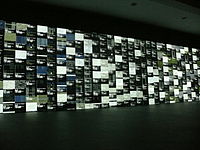
Another trend in art which has been associated with the term postmodern is the use of a number of different media together.
Telematic Art
Telematic art is a descriptive of art projects using computer mediated telecommunications networks as their medium. Telematic art challenges the traditional relationship between active viewing subjects and passive art objects by creating interactive, behavioural contexts for remote aesthetic encounters. Roy Ascott sees the telematic art form as the transformation of the viewer into an active participator of creating the artwork which remains in process throughout its duration. Ascott has been at the forefront of the theory and practice of telematic art since 1978 when he went online for the first time, organizing different collaborative online projects.
Appropriation art and neo-conceptual art
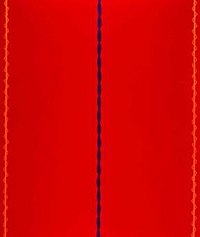
In his 1980 essay The Allegorical Impulse: Toward a Theory of Postmodernism,
Neo-expressionism and painting
The return to the traditional art forms of sculpture and
Institutional critique
Critiques on the institutions of art (principally museums and galleries) are made in the work of Michael Asher, Marcel Broodthaers, Daniel Buren and Hans Haacke.
See also
- Anti-art
- Anti-anti-art
- Classificatory disputes about art
- Cyborg art
- Electronic art
- Experiments in Art and Technology
- Gaze
- Late Modernism
- Modern art
- Modernist project
- Neo-minimalism
- Net.art
- New European Painting
- New Media art
- Post-conceptual
- Superflat
- Superstroke
- Remodernism
- Irving Sandler
- Virtual art
Sources
- The Triumph of Modernism: The Art World, 1985–2005, ISBN 978-0-15-666370-0
- Pictures of Nothing: Abstract Art since Pollock (A.W. Mellon Lectures in the Fine Arts), Kirk Varnedoe, 2003
- Art of the Postmodern Era: From the Late 1960s to the Early 1990s, Irving Sandler
- Postmodernism (Movements in Modern Art) Eleanor Heartney
- Sculpture in the Age of Doubt Thomas McEvilley 1999
References
- ^ Ideas About Art, Desmond, Kathleen K. [1] John Wiley & Sons, 2011, p.148
- ^ International postmodernism: theory and literary practice, Bertens, Hans [2], Routledge, 1997, p.236
- Arthur C. Danto
- ISBN 978-0-684-85781-7
- ^ Post-Modernism: The New Classicism in Art and Architecture Charles Jencks
- ^ Clement Greenberg: Modernism and Postmodernism Archived 2019-09-01 at the Wayback Machine, 1979. Retrieved June 26, 2007.
- ^ ISBN 978-0-631-19708-9
- ISBN 978-0-7486-0936-9
- ISBN 978-0-7190-1450-5
- ^ ISBN 978-90-5701-311-9
- ^ ISBN 978-90-5701-311-9
- ^ a b The Originality of the Avant Garde and Other Modernist Myths Rosalind E. Krauss, Publisher: The MIT Press; Reprint edition (July 9, 1986), Sculpture in the Expanded Field pp.287
- ISBN 978-0-415-93942-3
- ISBN 978-0-631-22867-7
- ISBN 978-0-7619-5580-1
- ^ ISBN 978-0-415-11256-7
- ISBN 978-0-7914-6956-9
- ^ de Zegher, Catherine (ed.) Inside the Visible, MIT Press, 1996
- ISBN 978-0-262-01226-3
- ISBN 978-0-226-22480-0
- ^ The Citadel of Modernism Falls to Deconstructionists, – 1992 critical essay, The Triumph of Modernism, 2006, Hilton Kramer, pp218-221.
- ^ The Originality of the Avant Garde and Other Modernist Myths Rosalind E. Krauss, Publisher: The MIT Press; Reprint edition (July 9, 1986), Part I, Modernist Myths, pp.8–171
- ^ The Originality of the Avant Garde and Other Modernist Myths Rosalind E. Krauss, Publisher: The MIT Press; Reprint edition (July 9, 1986), Part I, Modernist Myths, pp.8–171, Part II, Toward Post-modernism, pp. 196–291.
- ISBN 978-0-7190-4399-4.
- ISBN 978-0-415-06700-3.
- ISBN 978-0-415-14128-4.
- ISBN 978-0-19-508266-1
- ^ Kirk Varnedoe, 1946–2003 – Front Page – Obituary – Art in America, Oct, 2003 by Marcia E. Vetrocq
- ^ a b c General Introduction to Postmodernism. Cla.purdue.edu. Retrieved on 2013-08-02.
- ISBN 978-0-631-22708-3
- ISBN 978-0-671-67007-8
- ^ Avant-Garde and Kitsch Archived 2007-10-13 at the Wayback Machine
- ISBN 978-0-262-61046-9
- ISBN 978-0-8014-2494-6
- ^ "Fountain, Marcel Duchamp, 1917, replica, 1964". tate.org.uk. Tate. Retrieved 5 October 2018.
- ISBN 1854377663
- ISBN 0520213769
- ^ Tomkins: Duchamp: A Biography, page 158.
- ^ William A. Camfield, Marcel Duchamp's Fountain, Its History and Aesthetics in the Context of 1917 (Part 1), Dada/Surrealism 16 (1987): pp. 64-94.
- ^ THE INVENTION OF NON-ART: A HISTORY ArtForum International
- ISBN 978-0-415-28064-8
- ISBN 978-1-57181-130-1
- ^ De Zegher, Catherine, and Teicher, Hendel (eds.), 3 X Abstraction. New Haven: Yale University Press. 2005.
- ^ Aldrich, Larry. Young Lyrical Painters, Art in America, v.57, n6, November–December 1969, pp.104–113.
- ^ a b c Movers and Shakers, New York, "Leaving C&M", by Sarah Douglas, Art and Auction, March 2007, V.XXXNo7.
- ^ Martin, Ann Ray, and Howard Junker. The New Art: It's Way, Way Out, Newsweek 29 July 1968: pp.3,55–63.
- ^ Interior Scroll, 1975. Carolee Schneemann. Retrieved on 2013-08-02.
- ^ [The Living Theatre (1971). Paradise Now. New York: Random House.]
- ^ Gary Botting, The Theatre of Protest in America, Edmonton: Harden House, 1972.
- ISBN 978-1-63345-063-9]
- ISBN 0-8223-1399-5]
- ^ Michael Kirby, Happenings: An Illustrated Anthology, scripts and productions by Jim Dine, Red Grooms, Allan Kaprow, Claes Oldenburg, Robert Whitman (New York: E. P. Dutton & Co., Inc., 1965), p. 21.
- ISBN 978-0-7453-0003-0
- ^ Craig Owens, Beyond Recognition: Representation, Power, and Culture, London and Berkeley: University of California Press (1992), pp74-75.
- ISBN 978-1-57230-221-1
- ISBN 978-0-7453-0003-0
- ISBN 978-0-415-28064-8
- ISBN 978-0-415-24307-0
- ^ Richard Sheppard, Modernism-Dada-Postmodernism, Northwestern University
Press, 2000. p359. ISBN 978-0-8101-1492-0
- ISBN 978-0-415-90934-1
- ISBN 978-0-262-56107-5
- ^ ISBN 978-0-262-56107-5
- ISBN 978-0-19-284239-8
- ^ The Originality of the Avant Garde and Other Modernist Myths Rosalind E. Krauss, Publisher: The MIT Press; Reprint edition (July 9, 1986), Sculpture in the Expanded Field (1979). pp.290
- ISSN 1076-2922. Retrieved 26 October 2023.
- ISBN 978-0-631-23213-1
- ^ Craig Owens, Beyond Recognition: Representation, Power, and Culture, London and Berkeley: University of California Press (1992), p54
- ISBN 978-1-57230-221-1
- ISBN 978-0-7190-5211-8
- ISBN 978-0-495-00480-6
- ISBN 978-90-5701-132-0
- ISBN 978-0-415-14128-4
- ISBN 978-0-19-284239-8
- ^ Lyotard, Jean-François (1993), Scriptures: Diffracted Traces, reprinted in: Theory, Culture and Society, Volume 21 Number 1, 2004. ISSN 0263-2764
- ^ Pollock, Griselda, Inscriptions in the Feminine, in: de Zegher, Catherine, Ed.) Inside the Visible. Massachusetts: MIT Press, 1996
- ISBN 978-0-415-23804-5
- ISBN 978-2-13-051056-7
- ISBN 978-951-9355-55-9. Reprinted as: Lyotard, Jean-François, "Anamnesis: Of the Visible." In: Theory, Culture and Society, Vol. 21(1), 2004. 0263–2764
External links
 Media related to Postmodern art at Wikimedia Commons
Media related to Postmodern art at Wikimedia Commons

